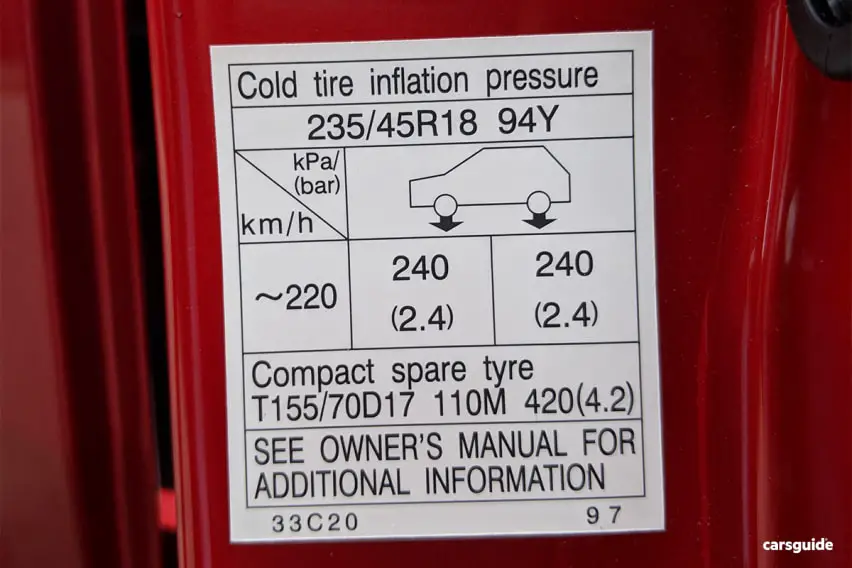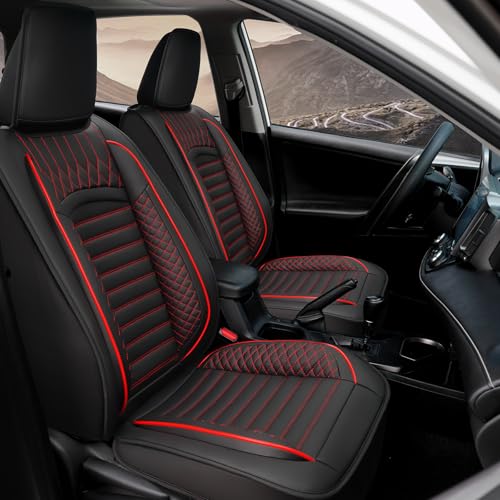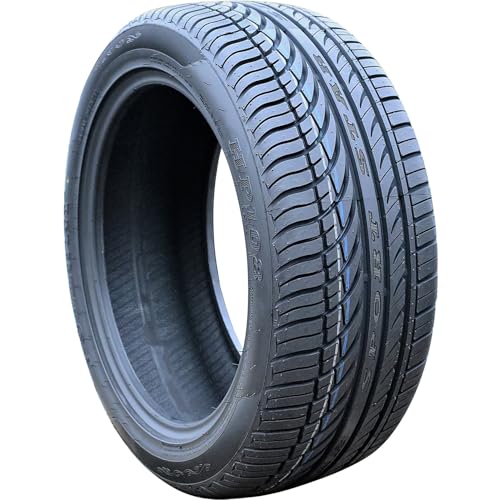The correct tire pressure for a Toyota Camry varies by model year and tire type. Generally, it ranges between 32 to 35 PSI (pounds per square inch).
Table of Contents
ToggleMaintaining the right tire pressure is crucial for your vehicle’s performance. Proper tire pressure ensures better handling, fuel efficiency, and safety. Under-inflated tires can lead to poor fuel economy and increased tire wear. Over-inflated tires may cause a harsh ride and reduce traction.
Knowing the correct tire pressure for your Toyota Camry helps you keep your car in top shape. In this blog, we will explore how to find the right tire pressure for your Camry and why it matters. Stay tuned to ensure your ride is always smooth and safe.
Importance Of Proper Tire Pressure
The correct tire pressure for your Toyota Camry is crucial. It ensures a safe and smooth ride. Maintaining the right pressure has many benefits. It affects safety, fuel efficiency, and tire life. Let’s dive into why proper tire pressure is so important.
Safety Considerations
Proper tire pressure keeps you safe on the road. It improves handling and braking. Under-inflated tires can cause accidents. They may lead to blowouts or skidding. Over-inflated tires can also be dangerous. They reduce traction and increase wear. Always check your tire pressure regularly. Follow the manufacturer’s guidelines.
Fuel Efficiency
The right tire pressure helps you save on fuel. Under-inflated tires create more resistance. This makes your engine work harder. As a result, it uses more fuel. Keeping tires properly inflated reduces this resistance. Your car moves more easily. You get better gas mileage and save money.
Recommended Tire Pressure For Toyota Camry
Maintaining the correct tire pressure for your Toyota Camry is crucial. It ensures safety, fuel efficiency, and tire longevity. This guide will help you understand the recommended tire pressure for your Toyota Camry.
Manufacturer’s Guidelines
The manufacturer provides specific guidelines for tire pressure. These recommendations are found in the owner’s manual or the driver’s side door jamb.
| Model Year | Front Tires | Rear Tires |
|---|---|---|
| 2018 – 2023 | 35 psi | 35 psi |
| 2012 – 2017 | 33 psi | 33 psi |
| 2007 – 2011 | 32 psi | 32 psi |
Following these guidelines ensures optimal performance and safety.
Seasonal Adjustments
Adjusting tire pressure according to the season is important. Cold weather causes tire pressure to drop. Warm weather increases it.
- Winter: Check tire pressure more frequently. Cold air reduces pressure.
- Summer: Monitor pressure for over-inflation. Hot air increases pressure.
Keep a tire gauge in your car. Check and adjust tire pressure regularly.
Proper tire pressure enhances your Toyota Camry’s performance. It also improves fuel efficiency and ensures safe driving.
How To Check Tire Pressure
Knowing the correct tire pressure for your Toyota Camry is crucial for safety and performance. Regularly checking your tire pressure can prevent accidents, improve fuel efficiency, and extend the life of your tires. In this section, you will learn how to check your tire pressure effectively.
Required Tools
Before you start, gather a few simple tools:
- Digital or manual tire pressure gauge
- Air compressor (optional)
- Owner’s manual
Step-by-step Guide
Follow these easy steps to check your tire pressure:
- First, ensure the tires are cold. Check pressure in the morning.
- Find the recommended tire pressure in the owner’s manual or on the driver’s door jamb.
- Remove the valve cap from one tire.
- Press the tire pressure gauge onto the valve stem.
- Read the measurement on the gauge. Compare it to the recommended pressure.
- If the pressure is low, use an air compressor to add air.
- Recheck the pressure with the gauge.
- Replace the valve cap. Repeat for all tires, including the spare.
Maintaining the correct tire pressure in your Toyota Camry is simple. With these steps, you can ensure your car runs smoothly and safely.
Common Tire Pressure Issues
Keeping the correct tire pressure for your Toyota Camry is crucial. Incorrect tire pressure can lead to various issues that affect your car’s performance and safety. Let’s explore some common tire pressure issues.
Underinflation
Underinflated tires can cause several problems. When tires do not have enough air, they can wear out faster and unevenly.
- Increased tire wear: More contact with the road can wear down the edges of the tire.
- Poor fuel efficiency: Your car uses more fuel to move underinflated tires.
- Reduced handling: It becomes harder to steer and control the vehicle.
Keep an eye on your tire pressure to avoid these issues. Check your tires regularly to ensure they are properly inflated.
Overinflation
Overinflated tires can also cause problems. When there is too much air in the tires, they become stiff and less flexible.
- Decreased traction: Less tire surface touches the road, reducing grip.
- Harsher ride: The car feels bumpier and less comfortable.
- Increased risk of blowouts: Overinflated tires are more likely to burst.
Check your tire pressure to ensure it is within the recommended range. This will help maintain your car’s performance and your safety.
Refer to your Toyota Camry’s manual for the correct tire pressure values. Regular maintenance and proper inflation can help you avoid these common tire pressure issues.
Impact Of Incorrect Tire Pressure
Incorrect tire pressure affects the handling and safety of a Toyota Camry. Proper tire pressure for a Toyota Camry is typically around 32 PSI. Always check the owner’s manual for exact specifications.
Incorrect tire pressure can affect your Toyota Camry in many ways. It can influence tire wear, handling, and overall performance. Maintaining the right tire pressure is crucial for safety and efficiency. Let’s explore the specific impacts.Tire Wear And Tear
Incorrect tire pressure causes uneven tire wear. Overinflated tires wear out the center tread faster. Underinflated tires wear out the edges more quickly. Both conditions reduce the lifespan of your tires. This means more frequent replacements and higher costs.Handling And Performance
Improper tire pressure impacts your car’s handling. Overinflated tires make the ride harsh and bumpy. They reduce the tire’s contact with the road. This can lead to poor grip and longer braking distances. Underinflated tires, on the other hand, make the car feel sluggish. They reduce fuel efficiency and increase the risk of tire blowouts. Proper tire pressure ensures optimal performance and safety. “`
Credit: www.reddit.com
Maintaining Optimal Tire Pressure
Keeping your Toyota Camry’s tires at the correct pressure is essential. It ensures safety, better fuel efficiency, and a smoother ride. Incorrect tire pressure can lead to uneven wear, poor handling, and even accidents. Maintaining optimal tire pressure is easy and offers many benefits.
Regular Checks
Check your tire pressure regularly. A good rule is to check it once a month. Also, check before long trips. Use a reliable gauge to measure the pressure. Always check when the tires are cold. This means the car hasn’t been driven for at least three hours.
- Use a tire pressure gauge
- Check the tires when they are cold
- Compare the reading to the recommended pressure
The recommended tire pressure for a Toyota Camry is usually found in the owner’s manual. It is also on a sticker inside the driver’s door. Keeping the pressure at the recommended level ensures the best performance.
Using Tire Pressure Monitoring Systems
Modern Toyota Camry models come with Tire Pressure Monitoring Systems (TPMS). These systems alert you when the tire pressure is too low. TPMS is a helpful tool to maintain optimal tire pressure.
- Check the dashboard for TPMS warnings
- If the light is on, check the tire pressure manually
- Inflate the tires to the recommended pressure if needed
TPMS can save you time and alert you to potential issues early. It is an important feature for safety and efficiency.
Maintaining the correct tire pressure in your Toyota Camry is crucial. Regular checks and using TPMS can help you keep your tires in top shape. This ensures a safer and more enjoyable driving experience.
Consequences Of Neglecting Tire Pressure
Maintaining the correct tire pressure is vital for the performance and safety of your Toyota Camry. Neglecting tire pressure can lead to several serious consequences. These issues can affect your driving experience and your wallet. Let’s explore some of these consequences.
Accidents
Incorrect tire pressure can lead to accidents. Under-inflated tires can cause poor handling. This reduces the car’s ability to respond swiftly in emergencies. Over-inflated tires can make the car bounce on the road. This affects traction and control, increasing the risk of accidents.
Increased Maintenance Costs
Ignoring tire pressure can lead to higher maintenance costs. Tires that are not properly inflated wear out faster. This means you will need to replace them more often. Under-inflated tires can also cause damage to other car parts, like the suspension.
To avoid these issues, check your tire pressure regularly. Use a reliable gauge and follow the manufacturer’s recommendations. This simple task can save you money and keep you safe on the road.
Credit: www.reddit.com
Tips For Extending Tire Life
Ensuring your Toyota Camry tires last as long as possible requires proper care. Follow these tips to extend tire life and keep your ride smooth and safe.
Proper Inflation
Always keep your tires at the recommended pressure. For a Toyota Camry, this is usually around 32 PSI. Check your owner’s manual or the sticker inside the driver’s door for exact numbers. Use a reliable tire gauge to measure pressure.
Underinflated tires wear out quicker and can be dangerous. Overinflated tires can cause a rough ride and uneven wear. Maintain the correct pressure to ensure a balanced and comfortable drive.
Routine Inspections
Regularly inspect your tires for wear and damage. Look for cracks, punctures, or any unusual wear patterns. Uneven wear can signal alignment or suspension issues.
Rotate your tires every 5,000 to 7,000 miles. This helps even out the wear and extends tire life. Check for nails or other sharp objects that could cause a slow leak. Clean your tires to remove debris and ensure they grip the road properly.
| Inspection Task | Frequency |
|---|---|
| Check Pressure | Monthly |
| Inspect for Damage | Monthly |
| Rotate Tires | Every 5,000-7,000 miles |
Credit: www.reddit.com
Frequently Asked Questions
What Is The Best Tire Pressure For A Toyota Camry?
The best tire pressure for a Toyota Camry is typically 32 psi for both front and rear tires. Check the owner’s manual or the driver’s side door jamb for specific recommendations.
Is 40 Psi Too High For Camry?
40 psi is too high for a Toyota Camry. The recommended tire pressure is usually between 30-35 psi. Check the owner’s manual or the tire placard on the driver’s side door for exact specifications. Maintaining proper tire pressure ensures safety and optimal performance.
How To Tell Which Tire Is Low On A Toyota Camry?
Check the tire pressure monitoring system (TPMS) on your Toyota Camry’s dashboard. It identifies the low tire.
Is 40 Psi Too High For Tires?
40 psi may be too high for some tires. Check your vehicle’s manual or tire sidewall for the recommended pressure.
Conclusion
Maintaining the correct tire pressure for your Toyota Camry is crucial. It ensures safety, improves fuel efficiency, and extends tire life. Check your tire pressure regularly. Refer to the owner’s manual or the sticker inside the driver’s door for the recommended PSI.
Proper tire care saves you money and keeps you safe on the road. Don’t overlook this simple yet important task. Drive safely and enjoy the benefits of well-maintained tires.
{ “@context”: “https://schema.org”, “@type”: “FAQPage”, “mainEntity”: [ { “@type”: “Question”, “name”: “What is the best tire pressure for a Toyota Camry?”, “acceptedAnswer”: { “@type”: “Answer”, “text”: “The best tire pressure for a Toyota Camry is typically 32 psi for both front and rear tires. Check the owner’s manual or the driver’s side door jamb for specific recommendations.” } } , { “@type”: “Question”, “name”: “Is 40 psi too high for Camry?”, “acceptedAnswer”: { “@type”: “Answer”, “text”: “40 psi is too high for a Toyota Camry. The recommended tire pressure is usually between 30-35 psi. Check the owner’s manual or the tire placard on the driver’s side door for exact specifications. Maintaining proper tire pressure ensures safety and optimal performance.” } } , { “@type”: “Question”, “name”: “How to tell which tire is low on a Toyota Camry?”, “acceptedAnswer”: { “@type”: “Answer”, “text”: “Check the tire pressure monitoring system (TPMS) on your Toyota Camry’s dashboard. It identifies the low tire.” } } , { “@type”: “Question”, “name”: “Is 40 psi too high for tires?”, “acceptedAnswer”: { “@type”: “Answer”, “text”: “40 psi may be too high for some tires. Check your vehicle’s manual or tire sidewall for the recommended pressure.” } } ] }
